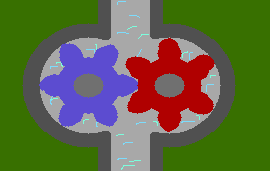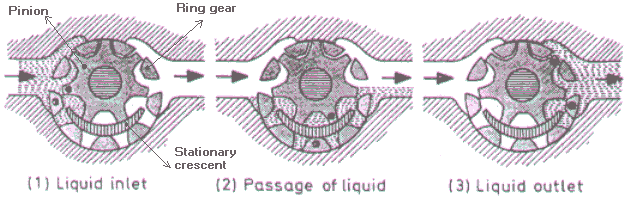Gear Pumps
Spur Gear or External-gear pump

Picture From www.animatedsoftware.com
A external-gear pump (called as gear pump) consists essentially of two intermeshing gears which are identical and which are surrounded by a closely fitting casing. One of the gears is driven directly by the prime mover while the other is allowed to rotate freely. The fluid enters the spaces between the teeth and the casing and moves with the teeth along the outer periphery until it reaches the outlet where it is expelled from the pump.
External-gear pumps are used for flow rates up to about 400 m3/hr working against pressures as high as 170 atm. The volumetric efficiency of gear pumps is in the order of 96 percent at pressures of about 40 atm but decreases as the pressure rises.
Internal-gear Pump

The above figure shows the operation of a internal gear pump. In the internal-gear pump a spur gear, or pinion, meshes with a ring gear with internal teeth. Both gears are inside the casing. The ring gear is coaxial with the inside of the casing, but the pinion, which is externally driven, is mounted eccentrically with respect to the center of the casing. A stationary metal crescent fills the space between the two gears. Liquid is carried from inlet to discharge by both gears, in the spaces between the gear teeth and the crescent.
